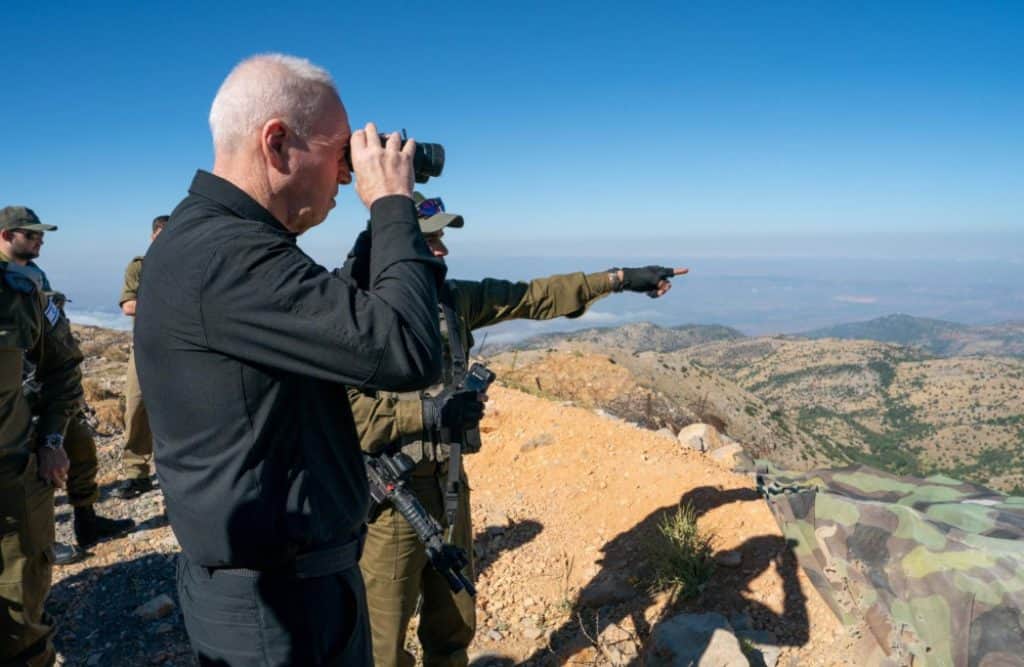
On July 7, Hezbollah launched several rounds of rockets and anti-tank missiles at Israel, wounding at least four people. Two of those injured, including an American citizen, suffered serious wounds.
The attacks followed several days of escalating clashes. On July 4, Hezbollah launched more than 200 rockets and 20 drones at Israel, killing an IDF soldier. The Iranian-backed terrorist group followed these attacks up with the escalation on July 7. In both cases, Hezbollah claimed to be retaliating for Israel killing senior Hezbollah commanders in Lebanon.
As Hezbollah ramped up its attacks on Israel, Israeli Minister of Defense Yoav Gallant visited IDF troops in an armored brigade on Mount Hermon, the mountain at the northern end of the Golan Heights.
“These are critical days in terms of exercising our power against an enemy that only responds to force. Even if we reach an agreement in the southern arena, we will continue fighting here, until we bring Hezbollah to reach an agreement and ensure the safe return of Israel’s northern communities to their homes,” Gallant said.
Gallant added that Hezbollah and Palestinian terrorist groups in Lebanon have lost 450 fighters since clashes began on the border on October 8, 2023. These casualties include the deaths of 15 Hezbollah commanders at the brigade level of the terrorist group, including three of Hezbollah’s division commanders. The Ministry of Defense assesses that this total represents 50 percent of Hezbollah’s senior commanders of these ranks in southern Lebanon.
Gallant has said several times during the war that even if there is a ceasefire in Gaza, the IDF may continue strikes against Hezbollah. Hezbollah has explicitly linked its attacks with the war in Gaza, essentially claiming it will stop the attacks if there is a ceasefire.
Gallant’s visit followed days of increasing tensions. On July 6, Hezbollah launched several drones at northern Israel, targeting areas near the city of Kiryat Shmona. The city was evacuated in October when Hezbollah’s attacks began, and it is mostly a ghost town today. The drone attacks set off sirens, and the IDF said it intercepted one of the drones. Two other drones “crossed from Lebanon fell in an open area in Beit Hillel,” the IDF said on July 6. Hezbollah claimed to have targeted an IDF artillery position. No one was injured in the attack, according to the IDF.
The same day as the drone attacks, Israel carried out an airstrike that killed Maytham Mustafa Al-Ataar, who the IDF described as “a key operative in Hezbollah’s Aerial Defense Unit.” The airstrike took place in the Baalbek area of Lebanon, around 70 miles north of the Israeli border. Israel accused Al-Ataar of the “planning and carrying out of numerous terror attacks against the State of Israel” and stated he traveled to Iran numerous times to gain “knowledge and assisted in building up the Hezbollah terrorist organisation’s force and arsenal of Iranian weapons.” Hezbollah took responsibility for launching a barrage of rockets in response, according to Iranian state media.
On July 7, Hezbollah began its attacks at around 10 am, and sirens sounded in 20 Israeli communities west of the Sea of Galilee. Most of these communities are Arab and Druze villages and towns. Hezbollah claimed it was targeting an IDF base with the rockets. The attacks took place around 20 miles inside Israel, much deeper than most Hezbollah targets. Israeli air defenses intercepted approximately 20 of the projectiles, but one rocket wounded a farmer.
The Iranian-backed group followed up the morning attack three hours later with a rocket barrage targeting Mount Meron, the tallest mountain in the Galilee. The group has often targeted an IDF air traffic control site on the mountain in the past nine months. Hezbollah took responsibility for the attack in a statement to Al-Mayadeen media, a pro-Iranian website. The group claimed it targeted an “espionage” site near the border, using “appropriate weapons,” Hezbollah terminology for what it sees as proportional attacks on Israel. The group often hits the border region with rockets, drones, and anti-tank missiles, claiming to target mostly military sites.
In the afternoon, Hezbollah hit the border community of Zarit with two anti-tank missiles. The IDF initially said one soldier was lightly wounded. The IDF also published footage of one of the attacks showing Hezbollah launching an anti-tank missile from the Lebanese border town of Ayta Ash Shab. “The Hezbollah terrorist organization continues to embed its military assets inside civilian areas in Lebanon and use them as human shields in its terrorist attacks against Israel,” the IDF said.
Israel’s Ynet reported that a 31-year-old American citizen was seriously injured in the anti-tank missile attack in Zarit. “The injured US citizen is an employee of a civilian company, which either sold or donated drones to reservists serving at the Lebanese border, and company employees arrived, apparently without permission, to instruct the soldiers on how to use the drones and to install some of the systems,” according to Ynet.
The harm to the American citizen appeared to raise eyebrows in the pro-Iranian camp because Al-Mayadeen noted that “it is still unclear what an American was doing in this area, which is a closed military [area].”
According to CNN reporting on a statement by the Galilee Medical Center, which is treating the injured US citizen, the “31-year-old man suffered shrapnel injuries to his upper body,” and his condition is “worsening.” Two others, “a soldier and a civilian,” were “hospitalized in a surgical department” after being injured by Hezbollah’s missiles.







